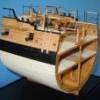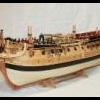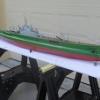-
Posts
6,358 -
Joined
-
Last visited
Reputation Activity
-
 wefalck got a reaction from Canute in Does color of gun carriages have to match that of the
wefalck got a reaction from Canute in Does color of gun carriages have to match that of the
The fundamental question is always, whether you go for an 'artisanal' look, or a 'realistic' one. In the former case you would have all artisanal freedom you like and can choose what pleases you aesthetically. In the latter case, you would need to try to confirm through research what might have been used on the prototype.
I am inclined to think that white-wash was quite prevalent on lower decks, because it makes the cramped space look more airy and reflects the little available light better (as already mentioned above). In addition, it has some bactericide and fungicide effects due to its high pH-value (which was not know scientifically, of course, at the time, but practical experience showed that less nasty, smelly things were growing in nooks and corners).
-
 wefalck got a reaction from dvm27 in Does color of gun carriages have to match that of the
wefalck got a reaction from dvm27 in Does color of gun carriages have to match that of the
The fundamental question is always, whether you go for an 'artisanal' look, or a 'realistic' one. In the former case you would have all artisanal freedom you like and can choose what pleases you aesthetically. In the latter case, you would need to try to confirm through research what might have been used on the prototype.
I am inclined to think that white-wash was quite prevalent on lower decks, because it makes the cramped space look more airy and reflects the little available light better (as already mentioned above). In addition, it has some bactericide and fungicide effects due to its high pH-value (which was not know scientifically, of course, at the time, but practical experience showed that less nasty, smelly things were growing in nooks and corners).
-
 wefalck got a reaction from Chuck Seiler in Dremel 8050 micro
wefalck got a reaction from Chuck Seiler in Dremel 8050 micro
Standard twist-drills are independent from machinery manufacturers. Standard twist-drills have a shaft diameter, which is the same as nominal drill diameter (for the British number drills this a bit more complicated). There are also twist-drills with thicker shaft, commonly 2.45 mm, 1.5 mm and 1.0 mm. The latter two one normally finds only in watchmakers' supply houses. All the other drills are found in many hobby stores or, indeed, on ebay in varying qualities. Shy away from carbide-drills, they are much less forgiving in a hand-drill than HSS ones.
-
 wefalck got a reaction from lmagna in Dremel 8050 micro
wefalck got a reaction from lmagna in Dremel 8050 micro
Not immediately on this Dremel machine, but on batteries from an environmental scientist: Ni-Cd are being gradually phased out due to environmental concerns over low collection and recycling rates. The cadmium is being dispersed in our environment, or worse in the environment of Third World countries, where many electric and electronic devices end their life in order to be 'recycled', when not fed into the proper recycling routes, but just binned. There, inter alia children burn the electrics and electronics waste in order to recover copper, gold and silver, but releasing nasty metals such as Cd and Hg into the environment and exposing themselves to these.
Li-ion batteries are a step away from this problem, but certainly not the last answer. Research and industry are working on other solutions.
As a rule, electric devices should not left to be charged unattended. Full stop. Physical chemistry tells you that during the charging process heat will be generated, which must be dissipated. If that is not possible for one or another reason, the device may heat up to ignition temperature. This applies to any kind of batteries. Li-ion batteries have a high charge per volume density and often are built into devices with poor heat dissipation capacity - which is the root cause of the problem.
So there is no problem as such with Li-ion batteries, as long as you keep an eye on your device.
-
 wefalck got a reaction from EricWilliamMarshall in Coming up short on eyebolts and don't want to buy a bagfull
wefalck got a reaction from EricWilliamMarshall in Coming up short on eyebolts and don't want to buy a bagfull
Why buying something that can be made for next to nothing ? If you don't have needle-nose pliers, or if they are too big, just put a nail with a diameter a tad smaller than the internal diameter of the eye needed into a piece of wood. Wind soft brass or copper wire around and cut off the excess. Adjust with a normal pair of pliers - you will never run out of eye-bolts again, if you have a reasonable stock of wire (which a shipmodeller usually has).
-
 wefalck got a reaction from Keith Black in SPERWER by KORTES - FINISHED - 1:30 scale - Friescheboeier Yacht
wefalck got a reaction from Keith Black in SPERWER by KORTES - FINISHED - 1:30 scale - Friescheboeier Yacht
Nice oar-locks !
-
 wefalck got a reaction from Canute in Dremel 8050 micro
wefalck got a reaction from Canute in Dremel 8050 micro
Standard twist-drills are independent from machinery manufacturers. Standard twist-drills have a shaft diameter, which is the same as nominal drill diameter (for the British number drills this a bit more complicated). There are also twist-drills with thicker shaft, commonly 2.45 mm, 1.5 mm and 1.0 mm. The latter two one normally finds only in watchmakers' supply houses. All the other drills are found in many hobby stores or, indeed, on ebay in varying qualities. Shy away from carbide-drills, they are much less forgiving in a hand-drill than HSS ones.
-
 wefalck got a reaction from lmagna in Dremel 8050 micro
wefalck got a reaction from lmagna in Dremel 8050 micro
Standard twist-drills are independent from machinery manufacturers. Standard twist-drills have a shaft diameter, which is the same as nominal drill diameter (for the British number drills this a bit more complicated). There are also twist-drills with thicker shaft, commonly 2.45 mm, 1.5 mm and 1.0 mm. The latter two one normally finds only in watchmakers' supply houses. All the other drills are found in many hobby stores or, indeed, on ebay in varying qualities. Shy away from carbide-drills, they are much less forgiving in a hand-drill than HSS ones.
-
 wefalck got a reaction from Canute in Dremel 8050 micro
wefalck got a reaction from Canute in Dremel 8050 micro
I don’t quite understand the point of the question. One is likely to need all sizes of drills at some point. From a practical perspective I would think that one can drill holes in a range from 0.5 mm to about 3 mm (or 1/8” for you imperial guys). Drills commonly go down to 0.3 mm, but I would use them only in a stationary machine or with a pin-vise. There are even smaller drills, but these are really delicate (and expensive).
-
 wefalck got a reaction from BETAQDAVE in SPERWER by KORTES - FINISHED - 1:30 scale - Friescheboeier Yacht
wefalck got a reaction from BETAQDAVE in SPERWER by KORTES - FINISHED - 1:30 scale - Friescheboeier Yacht
Nice oar-locks !
-
 wefalck reacted to KORTES in SPERWER by KORTES - FINISHED - 1:30 scale - Friescheboeier Yacht
wefalck reacted to KORTES in SPERWER by KORTES - FINISHED - 1:30 scale - Friescheboeier Yacht
Scepter.
After solder, as usually, broaching file…
-
 wefalck got a reaction from Captain Poison in In need of shipyard workers or boats crewmembers
wefalck got a reaction from Captain Poison in In need of shipyard workers or boats crewmembers
Not bad at all. If I may make a suggestion: I would not produce them with a base, but rather have some sprues or something sticking out of their feet - this would allow to drill appropriate holes into decks etc. for fixing them.
It might be also an idea to offer them at one of the 3D-printing service providers for scaleable printouts - thinking of smaller scales.
-
 wefalck got a reaction from Captain Poison in Dremel 8050 micro
wefalck got a reaction from Captain Poison in Dremel 8050 micro
Not immediately on this Dremel machine, but on batteries from an environmental scientist: Ni-Cd are being gradually phased out due to environmental concerns over low collection and recycling rates. The cadmium is being dispersed in our environment, or worse in the environment of Third World countries, where many electric and electronic devices end their life in order to be 'recycled', when not fed into the proper recycling routes, but just binned. There, inter alia children burn the electrics and electronics waste in order to recover copper, gold and silver, but releasing nasty metals such as Cd and Hg into the environment and exposing themselves to these.
Li-ion batteries are a step away from this problem, but certainly not the last answer. Research and industry are working on other solutions.
As a rule, electric devices should not left to be charged unattended. Full stop. Physical chemistry tells you that during the charging process heat will be generated, which must be dissipated. If that is not possible for one or another reason, the device may heat up to ignition temperature. This applies to any kind of batteries. Li-ion batteries have a high charge per volume density and often are built into devices with poor heat dissipation capacity - which is the root cause of the problem.
So there is no problem as such with Li-ion batteries, as long as you keep an eye on your device.
-
 wefalck got a reaction from JerseyCity Frankie in In need of shipyard workers or boats crewmembers
wefalck got a reaction from JerseyCity Frankie in In need of shipyard workers or boats crewmembers
Yes, the Preiser sculpting and anatomy is my benchmark. I have used them for one-off conversions. I cannot stand those garden dwarf-like 'wargaming' figurines - I gather the reason for their stocky built is to provide for more rugged handling during the game, but they are not good for scale models.
-
 wefalck got a reaction from Landlubber Mike in Best finish for wood ships
wefalck got a reaction from Landlubber Mike in Best finish for wood ships
There is no 'best' - it depends on what kind of look you try to achieve.
Unpainted wood on working sailing ships was either treated with Stockholm tar or linesee oil, or some concoction that contains either or, or both of these. The surface will have a light sheen or be matt, depending on age and exposure of the treatment.
From the late 19th century on yachts (and some high-grade passenger ships) would have unpainted wood varnished. Surfaces would range from satin to high gloss. The varnish would form an appreciable layer on top of the wood, unlike the Stockholm tar or lineseed oil that would soak in.
Many models prefer (it also seem to be a sort of convention for 'historical' models) an 'artisanal' look to their models, highlighting their woodworking etc. skills, rather than representing the actual look of the ship. For this any kind of surface treatment that is used in fine joinery can be used.
For the latter kind, my preferred method is to apply nitrocellulose-based wood-filler and rub this down with very fine (0000) steel-wool. This give a satin finish that deepens the wood colour without forming an appreciable layer on it. For small parts or carvings, one may prefer (diluted) shellac without filler, so that it doesn't clog up the details. Be sure to blow off any slivers of the steel-wool or otherwise you may get rust stains some time later.
-
 wefalck got a reaction from Oliver24 in Dremel 8050 micro
wefalck got a reaction from Oliver24 in Dremel 8050 micro
Not immediately on this Dremel machine, but on batteries from an environmental scientist: Ni-Cd are being gradually phased out due to environmental concerns over low collection and recycling rates. The cadmium is being dispersed in our environment, or worse in the environment of Third World countries, where many electric and electronic devices end their life in order to be 'recycled', when not fed into the proper recycling routes, but just binned. There, inter alia children burn the electrics and electronics waste in order to recover copper, gold and silver, but releasing nasty metals such as Cd and Hg into the environment and exposing themselves to these.
Li-ion batteries are a step away from this problem, but certainly not the last answer. Research and industry are working on other solutions.
As a rule, electric devices should not left to be charged unattended. Full stop. Physical chemistry tells you that during the charging process heat will be generated, which must be dissipated. If that is not possible for one or another reason, the device may heat up to ignition temperature. This applies to any kind of batteries. Li-ion batteries have a high charge per volume density and often are built into devices with poor heat dissipation capacity - which is the root cause of the problem.
So there is no problem as such with Li-ion batteries, as long as you keep an eye on your device.
-
 wefalck got a reaction from Rustyj in Dremel 8050 micro
wefalck got a reaction from Rustyj in Dremel 8050 micro
Not immediately on this Dremel machine, but on batteries from an environmental scientist: Ni-Cd are being gradually phased out due to environmental concerns over low collection and recycling rates. The cadmium is being dispersed in our environment, or worse in the environment of Third World countries, where many electric and electronic devices end their life in order to be 'recycled', when not fed into the proper recycling routes, but just binned. There, inter alia children burn the electrics and electronics waste in order to recover copper, gold and silver, but releasing nasty metals such as Cd and Hg into the environment and exposing themselves to these.
Li-ion batteries are a step away from this problem, but certainly not the last answer. Research and industry are working on other solutions.
As a rule, electric devices should not left to be charged unattended. Full stop. Physical chemistry tells you that during the charging process heat will be generated, which must be dissipated. If that is not possible for one or another reason, the device may heat up to ignition temperature. This applies to any kind of batteries. Li-ion batteries have a high charge per volume density and often are built into devices with poor heat dissipation capacity - which is the root cause of the problem.
So there is no problem as such with Li-ion batteries, as long as you keep an eye on your device.
-
 wefalck got a reaction from Canute in best way to paint the mayflower?
wefalck got a reaction from Canute in best way to paint the mayflower?
Another option would be to first spray-paint the respective area in yellow and then spray-paint a strip of plain water slide-transfers in green, cut this into triangles and apply these over the yellow area.
Depending on how the respective board fits in constructionally, it may be a good idea to do the painting, by whatever method, before the board goes on - easier to mask off and, if something goes wrong, it is easier to repair off the model.
-
 wefalck reacted to KORTES in SPERWER by KORTES - FINISHED - 1:30 scale - Friescheboeier Yacht
wefalck reacted to KORTES in SPERWER by KORTES - FINISHED - 1:30 scale - Friescheboeier Yacht
When I have made some pieces.
it comes to oil coating, lots of elements have to be attached before putting coating.
SсhootoverloopFok.
-
 wefalck got a reaction from Piet in Bristol Pilot Cutter by michael mott - 1/8 scale - POF
wefalck got a reaction from Piet in Bristol Pilot Cutter by michael mott - 1/8 scale - POF
That's the trouble of working at such a large scale: you can/have to represent all the details, but things are only an eighth of size ... 😏
Good job on the 'leathering' !
-
 wefalck got a reaction from Piet in Bristol Pilot Cutter by michael mott - 1/8 scale - POF
wefalck got a reaction from Piet in Bristol Pilot Cutter by michael mott - 1/8 scale - POF
That's Dutch style, the setting-up of the forestay. However, I had exactly the same thought as 'druxey'. The Dutch drill(ed) holes through the stem (which is normally then wider at the top as for those of other nations), which is akin to a fixed dead-eye.
I don't comment on the quality of the work, it speaks for itself ...
-
 wefalck got a reaction from Canute in Dremel 8050 micro
wefalck got a reaction from Canute in Dremel 8050 micro
Not immediately on this Dremel machine, but on batteries from an environmental scientist: Ni-Cd are being gradually phased out due to environmental concerns over low collection and recycling rates. The cadmium is being dispersed in our environment, or worse in the environment of Third World countries, where many electric and electronic devices end their life in order to be 'recycled', when not fed into the proper recycling routes, but just binned. There, inter alia children burn the electrics and electronics waste in order to recover copper, gold and silver, but releasing nasty metals such as Cd and Hg into the environment and exposing themselves to these.
Li-ion batteries are a step away from this problem, but certainly not the last answer. Research and industry are working on other solutions.
As a rule, electric devices should not left to be charged unattended. Full stop. Physical chemistry tells you that during the charging process heat will be generated, which must be dissipated. If that is not possible for one or another reason, the device may heat up to ignition temperature. This applies to any kind of batteries. Li-ion batteries have a high charge per volume density and often are built into devices with poor heat dissipation capacity - which is the root cause of the problem.
So there is no problem as such with Li-ion batteries, as long as you keep an eye on your device.
-
 wefalck got a reaction from pontiachedmark in Dremel 8050 micro
wefalck got a reaction from pontiachedmark in Dremel 8050 micro
Not immediately on this Dremel machine, but on batteries from an environmental scientist: Ni-Cd are being gradually phased out due to environmental concerns over low collection and recycling rates. The cadmium is being dispersed in our environment, or worse in the environment of Third World countries, where many electric and electronic devices end their life in order to be 'recycled', when not fed into the proper recycling routes, but just binned. There, inter alia children burn the electrics and electronics waste in order to recover copper, gold and silver, but releasing nasty metals such as Cd and Hg into the environment and exposing themselves to these.
Li-ion batteries are a step away from this problem, but certainly not the last answer. Research and industry are working on other solutions.
As a rule, electric devices should not left to be charged unattended. Full stop. Physical chemistry tells you that during the charging process heat will be generated, which must be dissipated. If that is not possible for one or another reason, the device may heat up to ignition temperature. This applies to any kind of batteries. Li-ion batteries have a high charge per volume density and often are built into devices with poor heat dissipation capacity - which is the root cause of the problem.
So there is no problem as such with Li-ion batteries, as long as you keep an eye on your device.
-
 wefalck got a reaction from mtaylor in best way to paint the mayflower?
wefalck got a reaction from mtaylor in best way to paint the mayflower?
Another option would be to first spray-paint the respective area in yellow and then spray-paint a strip of plain water slide-transfers in green, cut this into triangles and apply these over the yellow area.
Depending on how the respective board fits in constructionally, it may be a good idea to do the painting, by whatever method, before the board goes on - easier to mask off and, if something goes wrong, it is easier to repair off the model.
-
 wefalck got a reaction from mtaylor in Dremel 8050 micro
wefalck got a reaction from mtaylor in Dremel 8050 micro
Not immediately on this Dremel machine, but on batteries from an environmental scientist: Ni-Cd are being gradually phased out due to environmental concerns over low collection and recycling rates. The cadmium is being dispersed in our environment, or worse in the environment of Third World countries, where many electric and electronic devices end their life in order to be 'recycled', when not fed into the proper recycling routes, but just binned. There, inter alia children burn the electrics and electronics waste in order to recover copper, gold and silver, but releasing nasty metals such as Cd and Hg into the environment and exposing themselves to these.
Li-ion batteries are a step away from this problem, but certainly not the last answer. Research and industry are working on other solutions.
As a rule, electric devices should not left to be charged unattended. Full stop. Physical chemistry tells you that during the charging process heat will be generated, which must be dissipated. If that is not possible for one or another reason, the device may heat up to ignition temperature. This applies to any kind of batteries. Li-ion batteries have a high charge per volume density and often are built into devices with poor heat dissipation capacity - which is the root cause of the problem.
So there is no problem as such with Li-ion batteries, as long as you keep an eye on your device.







.thumb.jpeg.fc5d633a7b34428fcf19419a73d56d55.jpeg)








